ISSN ONLINE(2320-9801) PRINT (2320-9798)
ISSN ONLINE(2320-9801) PRINT (2320-9798)
S.Sangeetha1, M.Manimozhi2, S.Jayanthi3
|
| Related article at Pubmed, Scholar Google |
Visit for more related articles at International Journal of Innovative Research in Computer and Communication Engineering
This project proposes the energy management for smart environment. The overall control scheme is mainly governed by an embedded microcontroller. Economic crisis and the risen energy price have forced every country to reduce their energy usage and try to be economical on energy consumption. In this project IR sensors are used to find out the intruder enters the home and the devices are controlled using zigbee (wireless transmission). The system will count the number of human presence in the room or hall. This process is useful to save the electrical power and the system will turn on/off every plugged electrical appliances including light bulbs, fans, TV, etc. LDR senses higher light intensity at day time so that the relay will turn off the light bulbs, the devices will be automatically turned on at night times, and this will typically save the electricity. The temperature sensor used to sense the temperature range of the home, if it exceeds the threshold temperature fan will be automatically turned ON using relay, when temperature reaches normal condition relay will turn OFF the fan. The whole process is based on the human count inside the particular room/hall. Thus based on the human count, every devices inside the room/hall is controlled using sensors and zigbee technology.
Keywords |
| Data fusion, localization, IR(Infra red sensor), received signal, zigbee |
INTRODUCTION |
| The indoor location information is important for a heating, ventilating, and air conditioning system, illumination adjustment, humidity control, robot service, and so on. Many researches discuss indoor human and robot localization systems however, most of these systems are imprecise, cannot manage multiple targets, or have expensive implementation costs. These different localization techniques include: Active Badge that used IR sensors, Active Bat that uses ultrasonic sensors, Easy Living that used vision sensors, Motion Star that used a dc magnetic tracker, and RADAR that used a wireless local area network. Irfan et al. developed a neural-based approach to obtain the location of user. |
| In order to detect the presence of resident the location-aware system uses an array of IR sensors. IR sensors which is present on the ceiling with overlapping detective areas with adjacent sensors, can detect the presence of a resident. This system can be a invalid when there are multiple targets or at vacant zones are present.. In this study, we propose an indoor localization and monitoring system, which is based on a wireless and IR (WIR) sensory fusion system. The location information obtained from the sensor and RF propagation model can be improved with the WIR system. We also propose a WIR inference algorithm, which can generate a more reliable positioning estimate of targets. This system aims to accurately locate a target. |
| A WIR localization system can monitor multiple targets with relative good resolution. The main contributions of this study are as follows. |
| 1) Develop an RF and IR integrated system, which is useful in locating and monitoring people and robots in an indoor environment. |
| 2) Develop an inference-based algorithm for wireless and sensory fusion system, where the proposed algorithm can be extended to binary sensor localization system. |
| 3) Propose a methodology that can register vacant zones to improve the accuracy of localization. |
II. LITERATURE REVIEW |
| REN C. LUO, FELLOW, IEEE, AND OGST CHEN,WIRELESS AND PYROELECTRIC SENSORY FUSION SYSTEM FOR INDOOR HUMAN/ROBOT LOCALIZATION AND MONITORING , IEEE/ASME TRANSACTIONS ON MECHATRONICS, VOL. 18, NO. 3, JUNE 2013 |
| This algorithm determines the fused position from both the PIR localization system and RF signal localization system, which utilize the received signal strength propagation model. With an accurate localization mechanism for the indoor environment, the provision of appropriate services for people can be realized. |
| M. Weiss, D. Guinard, “Increasing Energy Awareness ThroughWebenabled Power Outlets”, in proc. of MUM 2010 (9th ACM Inter.Conf. on Mobile and Ubiquitous Multimedia), Limassol, Cyprus, Present a device-level energy monitoring system that is based on off the-shelf components.Enables users to monitor, control, and compare the electricity consumption of their appliances |
| BojanMrazovac, Milan Z. Bjelica, D raganKukolj, Senior Member, IEEE,Branislav M. Todorovic, Member, IEEE and Nikola Teslic, Member, IEEERT-RK Computer Based Systems, Novi Sad, Serbia ,’A Human Detection Method for Residential Smart Energy Systems Based on Zigbee RSSI Changes,’2012.Using the presented solution it is easy to implement human detection on various ambient intelligence systems.Based on received signal strength indication |
| C. Chao-Chun, W. Ding-Chau, H. Yon-Ming, “A Novel Method for Unstable-signal Sensor Localization in Smart Home Environments”, International Journal of Smart Home, vol. 2, no. 3, July 2008.The verification-based localization method (vblm) to improve the positioning accuracy in the unstable-signal wireless sensor network is used. the sensor node use another neighbouring beacon to assist ,to verify the quality of received signal under acceptable communication cost, and thus, the noisy signals can be removed to avoid increasing the error in the localization. |
| J. Han, H. Lee, K.R. Park, “Remote-Controllable and Energy-Saving Room Architecture based on ZigBee Communication”, IEEE Trans. on Consumer Electronics, Vol. 55, No. 1, pp. 264-268, 2009.Remote-controllable and energy-saving room architecture to reduce standby power consumption to make the room easily controllable with an IR remote control of a home appliance. |
III. PROPOSED SYSTEM |
| In this project the transmitter consists of IR sensor, temperature sensor, LDR, and zigbee for transmission. The intruders entering the room can be counted using the IR sensors that are fixed near the entrance, whenever the intruders enter the room or hall the count will be shown using LCD (Liquid Crystal Display). The temperature sensor senses the temperature that is present in the room and the sensed temperature is used to control fan based on the temperature. If the temperature exceeds the threshold value the fan will be turned on. The fan will be turned off if the temperature is below the threshold value. The LDR(Light Dependent Resistor) is used to sense the light luminescence and it is used to turn off the devices if the luminescence is high.The various applications of LDR include smoke detection, automatic lighting control, batch counting and burglar alarm systems. The multichannel ADC is used to convert the analog values to digital values from Temperature and LDR sensor. The Zigbee is used for wireless transmission between transmitter and receiver. |
| At the receiver side relays are used to control the appliances, thus the number of appliances can be controlled based on the human count, here zigbee is used for wireless transmission. Based on the human count the appliances can be controlled,and the energy consumption can be minimized based on the intensity and the room’s temperature. The LCD (Liquid Crystal Display) is used to display the number of human present in the room. |
| The system will respond to the presence of human and various parameters such as amount of light present in surrounding, temperature around the surrounding. The system will reduce the power consumption and usage according to number of human in the location. |
| Improves the design of smart homes and energy aware networks without expensive processing algorithms. It is easy to implement the human detection on various Intelligence systems. The processing power for the detection. The various advantages of the proposed system is given as follows: |
| 1. Improves the automation of smart homes and energy aware networks without expensive processing algorithms. |
| 2. Easy to implement human detection on various intelligent systems. |
| 3. The processing power for the detection is limited. |
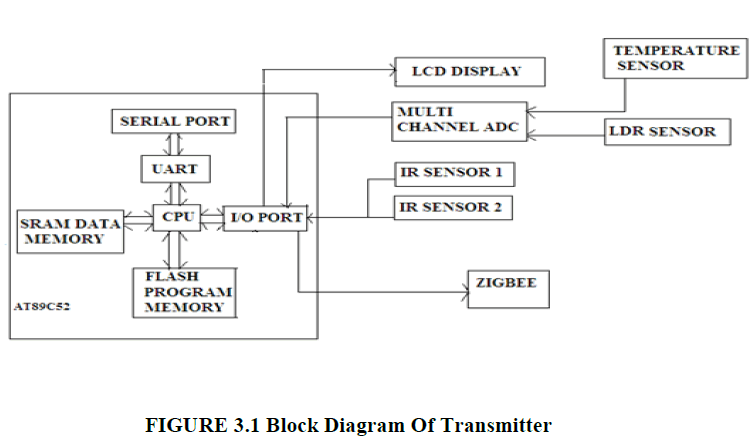 |
| The transmitter is the device that is used for transmitting information to the receiver side .Inthis the transmitter side has temperature ,LDR sensor it senses temperatue and intensity of light and sends the range to the receiver . |
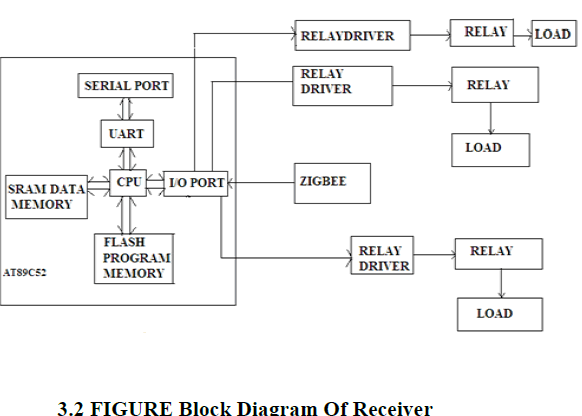 |
| The receiver is the one that is used for receiving information from that transmitter. Based on the information from the transmitter side it responds. |
IV. RESULT |
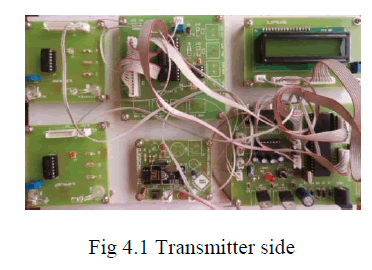 |
| The transmitter contains 8 bit microcontroller, IR sensor, ADC, LCD,Temperature sensor, LDR sensor and Zigbee for transmission. |
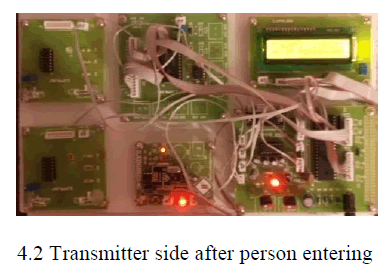 |
| The intruders entering the room can be counted using the IR sensors that are fixed near the entrance, whenever the intruders enter the room or hall the count will be shown using LCD (Liquid Crystal Display). The temperature sensor is used to control fan based on the temperature. If the temperature exceeds the threshold value the fan will be turned on. The fan will be turned off if the temperature is below the threshold value. The LDR is used to sense the light luminescence and it is used to turn off the devices if the luminescence is high. The multichannel ADC is used to convert the analog values to digital values from Temperature and LDR sensor. The Zigbee is used for wireless transmission between transmitter and receiver. |
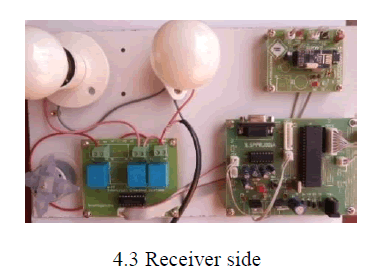 |
| The receiver side contains microcontroller, relay,load. The relay is used for switching purposes. |
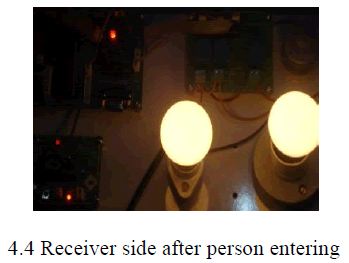 |
| Based on the information (i.e) the no of humans present in the room that is provided by the transmission side the load like light, fan are adjusted automatically. |
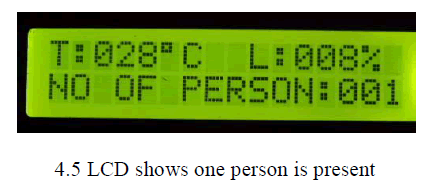 |
| This snapshot shows the no of person present, temperature, light intensity of the room.In this the no of person present is one . |
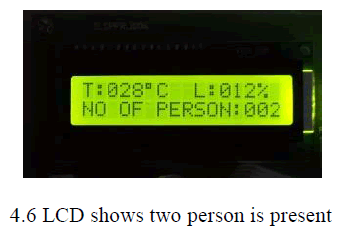 |
| This shows that the no of persons is two. The luminance value ,temperature are also displayed in the LCD .this information helps to adjust the home appliances. |
V. CONCLUSION AND FUTURE WORK |
| Economic crisis and the risen energy price have forced every country to reduce their energy usage and try to be economical on energy consumption. This trend is moving towards the same direction as the present social environment where sciences and technology are playing a big part in our daily life. |
| Thus in this project the multiple target identification is used to control the home appliances. This process is useful to save the electrical power and the project can also be very useful in localizing people in offices, schools, colleges.This application can also be extended for military application for localizing multiple targets. |
| The future work is to provide the additional facilities such as hand gesture recognition, voice controlled devices in order to make the smart environment flexible to specially challenged persons and to make the smart environment compatible to all people. |
References |
|